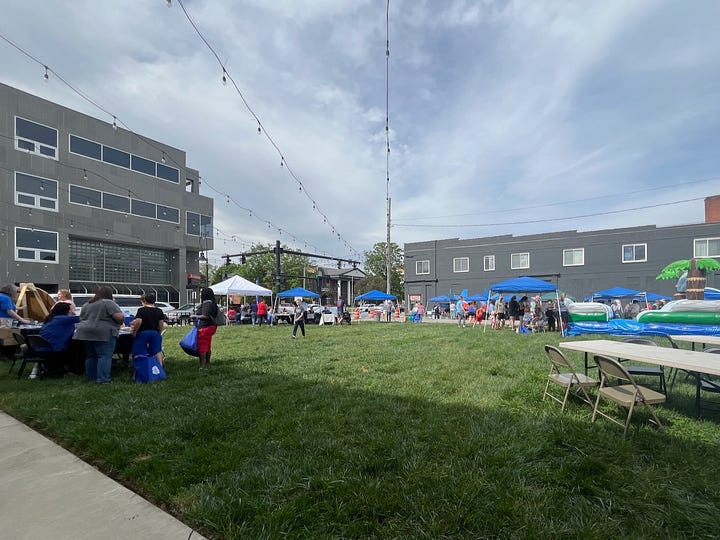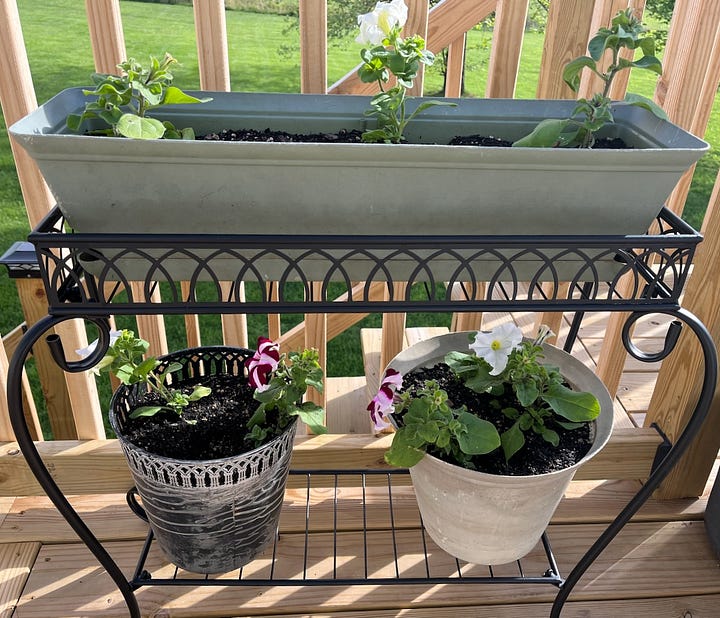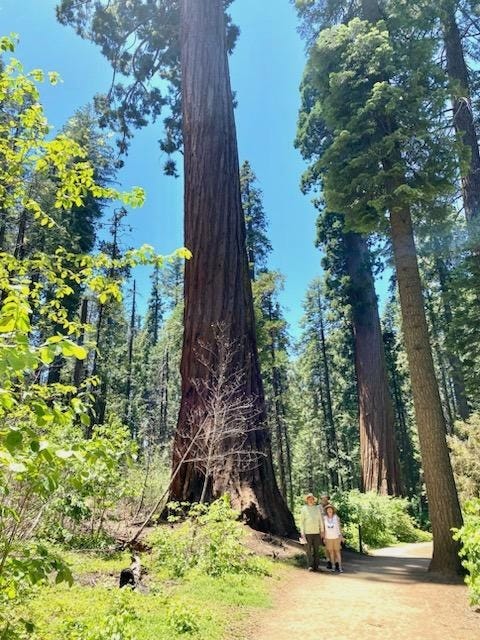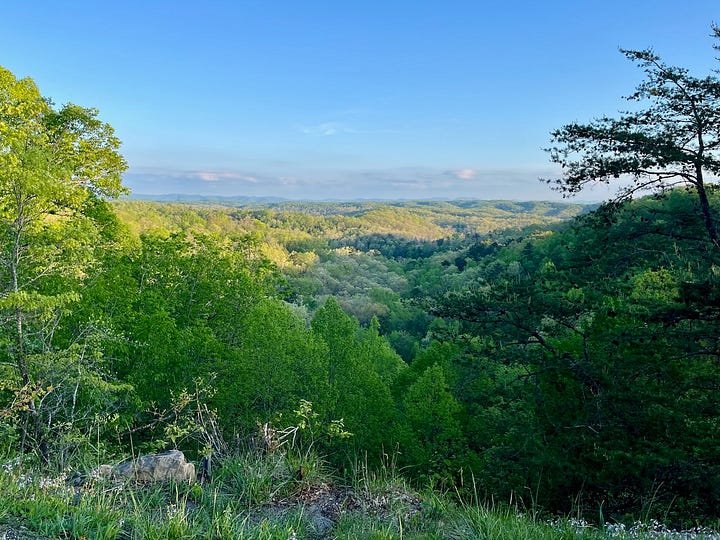Happy 55th birthday to Earth Day!
Thoughts on caring for our first mother, written 25 years apart
Earth Day 2025
Last Tuesday, I went to our town’s Earth Day celebration in a park that did not exist when I moved here more than 20 years ago. I picked up information about disaster preparedness, grabbed a couple free books for my grandbaby, and ate a small bag of popcorn as I caught up with friends.
My main goal, however, was to get free trees.
I have tried this before, but last year, I was too sick to attend, and the year before that, the trees weren’t suited to the growing conditions on the acre of land for which I’m privileged to care. This year, however, I met with success and came home with a hazelnut and a wild plum, which were later joined by a second hazelnut gifted by a friend.
In my Comfort of Crows journal this week, the prompt was to think about places in nature I loved as a child. I realized very quickly they all have something in common: water and/or trees. No wonder, then, that I have probably planted more trees than anyone else in my little cul-de-sac, though the two houses closest to the river still have far more trees total (and yes, I envy them!).
The act of planting is such a joy—the air ruffling my hair, the sun warming my skin, the dirt under my nails, the satisfaction of physical labor and seeing these for-now-small life forms adjust to their new home.
I am probably done planting new things for the year, and I have to say it has felt especially rewarding. The first few months of 2025 have been so full of fear and overwhelm that it feels like a huge relief to be able to do something concrete for not just my but also the common good.
I hope the trees will be happy here. I did my best to follow the planting guides that accompanied them, in part thanks to a neighbor who lent me garden tools I do not have. The flowers, peppers and tomatoes I planted a couple weeks ago have already grown and are delighting me with their shades of green and brightly colored flowers. I like to imagine the saplings following their lead on a larger scale, stretching their roots, finding their way through the soil, reaching toward the water that runs underground between our houses.
Tree time is so different time than human time, especially in the 21st century. Thinking about the plants and their roots helps me to slow down, take care, and understand just how much all of us, human and more-than-human, need each other.
This morning in the woods, I watched a caterpillar. It was not the cute fuzzy kind—no black-and-orange wooly bear. In fact, there was a time when I would have stepped back from all those legs and spiky hairs, feeling vaguely creeped out. Recently, however, I learned that tufted titmice raise their young on them. If I love tufted titmice—and I do—why not spend a little time getting to know their lunch?
I bent down to watch it more closely, whereupon it hesitated and raised its head. I could almost swear I heard its questions. What is this shadow blocking my path? Can I get around these beasts? What on earth is that smell?
To be fair, I don’t actually know if or what caterpillars think. I guess I could Google it—I imagine Gemini A.I. would have some pretty hilariously inaccurate responses, below which I would likely find some actual information, but for now, I’m going to stick with curiosity instead. It feels like as good a start as any to forging the kinds of kinship our beautiful, beleaguered planet so desperately needs.
As promised last week, I’m sharing Ruth’s Rural Reflection from Earth Day 2000. It’s a gentle reminder for 21st-century readers that environmental concerns are neither all that new nor, historically speaking, all that controversial, and that they pertain to everyone, not just tree-huggers like me.


Rural Reflections
By Ruth Dennis
Earth Day
Yesterday, April 22, was Earth Day, the first of the new century and the 30th anniversary of that first Earth Day, April 22, 1970.
The first Earth Day, initiated by U.S. Sen. Gaylord Nelson, brought current and long-term environmental issues to the forefront.
While we were out picking up roadside trash, cleaning up park sites that first Earth Day, we returned from these and other efforts to read and to listen to the media and to learn about the need for environmental protection. We became aware that first Earth Day that these needs not only were immediate but were world-wide needs.
Much has been accomplished since that first Earth Day 30 years ago. But so much more is needed, even after 30 years of endeavor. Environmental concerns are world-wide and actions need to be taken now. Earth Day is more than a national time for reflection and action.
We have had some success stories. The bald eagle is no longer on the endangered species list. Manufacturers have had to meet clean air standards. Agricultural use of pesticides and herbicides have been regulated. We have added to our National Park systems—the last and most recent of them the Sequoia National Forest to protect the giant Redwoods. Steps are being taken to reduce the automobile traffic, resulting in air pollution, into and out of our most popular national parks even as they are continuing to be accessible to the thousands who visit them every year.
One of my most personal environmental ‘success stories’ is the designation of Pine Creek in northern Pennsylvania as a scenic river. This protects the natural beauty of the area from overdevelopment. Farmland protection legislation has been enacted, protecting acres of farmland from non-agricultural development. This is another ‘success story’ but one with much more to be done. It has been said over and over again that “every time we take another acre of farmland out of production, we have lost more of our irreplaceable natural resources.”
It was the Earth Day special issue of Time magazine that provided me with much to think about. I read many of the articles, including those dealing with environmental issues in third world countries, beginning to realize the scope of their problems and their impact on us.
I admit I ‘surfed’ some of the magazine features but not the one titled “Sprawl.” Urban sprawl has been and still is a major environmental concern of mine. Even though I live out in farm country I have on several occasions written about my personal feelings about urban sprawl.1 For me, some of them are worth repeating.
I have witnessed urban sprawl in Florida, in Virginia, in Ohio, in Indiana, and many other areas. I have witnessed the effects of urban sprawl much closer to home.
I have watched mall after mall being built on the fringes of the suburbs while the smaller malls and Main Street stores close or struggle to remain open. I remember that when I was growing up in the suburbs, I could ride my bike to nearly open country. I was able to shop for my mother at the neighborhood grocery at the end of the block.
Now when l return to the same suburb which fortunately has maintained its tree-lined streets, I find that it is many miles to open country. Malls and more malls, fast food restaurants, office complexes line the major highways. Traffic is, more often than not, bumper to bumper. Parking lots are filled to capacity. And still more building goes on even as some of the smaller malls and retail outlet stores close.
The economical as well as environmental effects of urban sprawl should be of concern no matter where we live. Sprawl, we are reminded, costs taxpayers dollars to support the new infrastructure and costs the loss of opportunities to invest in existing communities and neighbors. Every time an acre of farmland is sold, more of our natural and irreplaceable resources are taken.
Yesterday was Earth Day, the first of the new century and the 30th anniversary of that first Earth Day. We have been given a challenge. Environmental issues affecting us are world-wide. Environmentalist Mark Hertsgaard has written, “the history of environmentalism is largely the story of ordinary people pushing for change.”2 Will there be ‘success stories’ resulting from the efforts of ordinary people to be told on Earth Day April 22, 2001?


See, for example, our August 2023 post, “Unlimited Sprawl Area?”
The hyperlink is my addition, as I suspect I am not the only one who appreciates the opportunity to learn more about the work of climate journalists.



